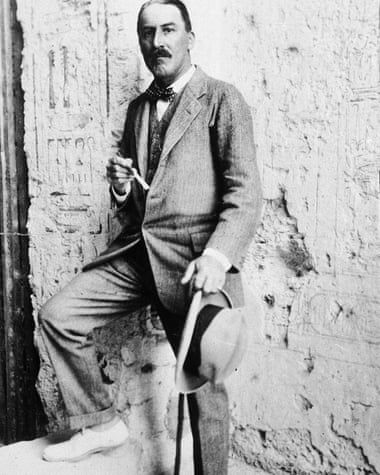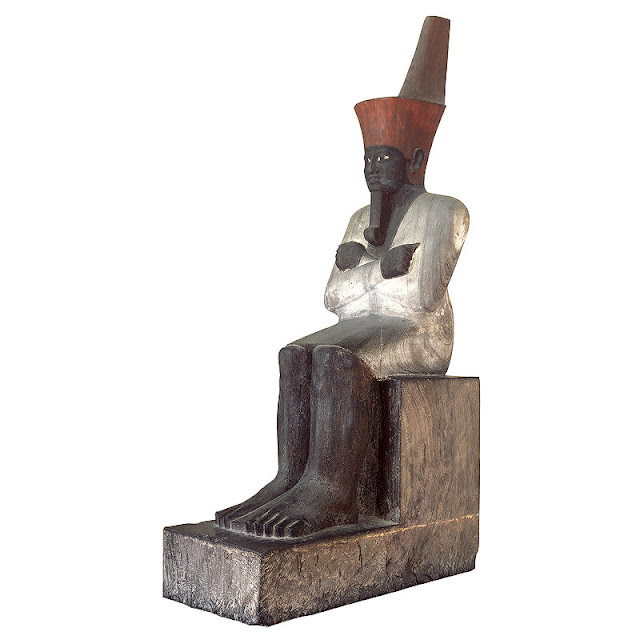
Howard Carter, a British archaeologist born on May 9, 1874, in Swaffham, Norfolk, England, is known for his significant contribution to Egyptology. In 1922, he discovered the most complete tomb of King Tutankhamun, which remains one of the most celebrated and richly endowed discoveries in the history of Egyptology. Carter passed away on March 2, 1939, in London.


Here is the story of his accidental discovery of one of the ancient heritages, as we might know it from the acts of the adventurers, with heartfelt thanks to the brilliant Marie Grillot.
The pic at the top via The Collector.
Carter finds a grave under his horse’s hoof!

via égyptophile
It was in October 1891 that Howard Carter arrived in Egypt to work as a draftsman and copyist for Percy Edward Newberry at the Egypt Exploration Foundation. Then, from 1893, still for the EEF, but this time under the direction of Edouard Naville, he copied the bas-reliefs of Deir el-Bahari intended to illustrate the Egyptologist’s work “The Temple of Deir el-Bahari”.
In this context, the one who, in November 1922, will emerge from oblivion, Tutankhamun will make, in an entirely fortuitous manner, his first discovery…
This “adventure” will stretch over two years and is worthy of Indiana Jones! It began in November 1898, on an exceptionally grey and rainy day in the Theban necropolis and the rocky cirque of Deir el-Bahari.
Carter is concerned about the impact of these rains on the temple murals. So, he decides to go to the site “with his colleague Charles Sillem” to observe and estimate potential damage.

its location (pit) is visible here
While he is in front of the temple of Montouhotep, his horse’s foot sinks into a hole… and they both fall! Carter gets up and hastens to examine what caused the fall. “Looking in the small hole formed there, I saw the traces of stonework”, he relates.
He was very intrigued and then opened up to Edouard Naville. As this sector is not in the area of his concession, he attaches little importance to it and does not encourage him to carry out other investigations.
For his part, Howard Carter will not forget this place; he promises to return there to further the research.
To do this, he knows that he must wait for his professional situation to evolve, which will happen quickly. Indeed, in 1899, Gaston Maspero, back at the head of the Antiquities Service, appointed him general inspector of monuments in Upper Egypt.
The following year, finally feeling free to carry out his first “independent” excavation, Howard Carter returned to the site and saw his intuition confirmed: it was indeed a burial! The work to clear what will be known as “Bab el-Hossan” (the horse’s grave) will prove gigantic!

Portrait of a young Howard Carter (author and date unknown)
The opening, which will have to be enlarged, leads to a corridor dug into the rock, 17 meters deep, leading to a sealed door. The clearing carried out with a large team that nevertheless takes turns tirelessly takes an incredible amount of time.
Behind the door, Carter encounters a new 150-meter corridor leading to a large room. Inside, draped, wrapped, and wrapped in linen, is a giant statue!
A well leads to a second chamber located around thirty meters lower. In it, Carter finds vases, pots, and boat models. In another well, a wooden chest bears the name of a pharaoh. This inscription will allow the statue to be identified.

discovered in 1900 by Howard Carter in what is generally referred to as: “Bab el-Hossan.”
Egyptian Museum in Cairo – JE 36195
It is made of painted sandstone and is 1.38 m high and 0.47 m wide. It represents Montouhotep II, ruler of the 11th dynasty. He sits on his throne, wearing the red crown of Lower Egypt and the white habit of jubilee (sed). His broad face, full lips, and a false beard are black.
Its eyes are painted white with black pupils. His hands are black, and his arms are crossed on his chest in the Osiriac position. His legs, also black, are very thick, even disproportionate. In their “Official Catalog of the Egyptian Museum in Cairo,” Mohamed Saleh and Hourig Sourouzian put forward this interesting hypothesis about the colour of its complexion: “It seems that the statue was painted black before burying it.”
As for Rosanna Pirelli (“The Wonders of the Egyptian Museum in Cairo”), she analyzes this particular representation of the sovereign as follows: “This is a strong and hieratic image of the second unifier of the pharaonic state after Menes. The statue symbolizes the double nature of the pharaoh who, during his lifetime, embodies the falcon god Horus, the mighty conqueror, while in death, he is identified with Osiris, the sovereign of the deceased.

discovered in 1900 by Howard Carter in what is generally referred to as: “Bab el-Hossan.”
Egyptian Museum in Cairo – JE 36195 – photo of the museum
Did Howard Carter discover the tomb of the great pharaoh? Mohamed Saleh and Hourig Sourouzian say, “The statue of Montouhotep had been ritually buried in a vault under the terrace (of his temple) and which seems to have been the initial tomb of the king, before having been transformed into a cenotaph. The entrance from this vault opened into the forecourt of the funerary monument of Montouhotep.”
Montouhotep II (“may Montu be satisfied”) reigned between 2061 and 2010 BC. AD. He led an important policy of cultural and commercial restoration.
Location of the temple of Montouhotep (partly ruined today)
in the rocky cirque of Deir el-Bahari

His funerary complex located at Deir el-Bahari was, perhaps, according to the hypothesis put forward by Edouard Naville, a temple with a double terrace topped by a small pyramid. Today, it is primarily degraded and cannot be visited. However, it can be seen from the temple of Hatshepsut, or better yet, an overview of it from the path linking Deir el-Bahari to Deir el-Medineh, which overlooks it.
This statue, “found under the hoof of a horse,” is exhibited at the Cairo Museum (JE 36195). It represents a magnificent example of the renaissance of Egyptian art from the beginning of the Middle Kingdom…
It is important to point out that, in “Howard Carter, The Path to Tutankhamun”, T.G.H. James tells us that this discovery had not been up to what Howard Carter had expected… “His disappointment was deep enough in itself, but worse still, it was increased by the fact that he had committed the stupidity to inform Lord Cromer, the British Consul General, who actually held power in Egypt, suggesting that it was possible that a tomb, possibly royal, had been found. As Maspero wrote to Naville: ‘ ‘He announced his discovery too early to Lord Cromer. Lord Cromer came to witness his success and is now in despair, having been unable to show him anything of what he had predicted. I console him as best I can because “He’s a really good boy, and he does his duty very well.”
Unfortunately, this experience led Nicholas Reeves to say in “Ancient Egypt: The Great Discoveries” that Carter then decided that, for any possible future discovery, he would wait until he was absolutely sure of what he had found before making the announcement. For Tutankhamun, he adopted this strategy:”…
Sources:
Herbert Eustis Winlock, Excavations at Deir El Bahri 1911-1931, The Macmillan Company, New York, 1942 https://archive.org/details/Winlock_Deir_El_Bahari_1911-1931 Thomas Garnet Henry James, Howard Carter, The path to Tutankhamun, TPP, 1992 https://archive.org/stream/HowardCarterThePathToTutankhamunBySam/Howard+Carter+The+Path+to+Tutankhamun+By+Sam_djvu.txt
Nicholas Reeves, Richard H. Wilkinson, The Complete Valley of the Kings, The American University in Cairo Press, 1996
Mohamed Saleh, Hourig Sourouzian, Official Catalogue of the Egyptian Museum in Cairo, Verlag Philippe von Zabern, 1997
Francesco Tiradritti, Treasures of Egypt – The wonders of the Egyptian Museum in Cairo, Gründ, 1999
Nicholas Reeves, Ancient Egypt. The Great Discoveries, Thames & Hudson, 2002, The Great Discoveries of Ancient Egypt Editions du Rocher, 2001
National Geographic Guide, The Treasures of Ancient Egypt at the Egyptian Museum in Cairo, 2004
The Egyptian Museum in Cairo, Abeer El-Shahawy, Matḥaf al-Miṣrī, American Univ in Cairo Press, 2005
Statue of King Mentuhotep the Second http://www.globalegyptianmuseum.org/record.aspx?id=14914 The Egyptian Museum in Cairo, Abeer El-Shahawy, Matḥaf al-Miṣrī

Published June 21 2014, by Marie Grillot
Labels: bab el-hossan Carter Deir_el-Bahari hossan the tomb of the horse Montouhotep naville
I didn’t know this archaeologist and I found your greats article truly fascinating.
Thank you for sharing the results of your precious research, dear Aladin ❣️
LikeLiked by 1 person
Thank you, Luisa, my friend. Howard Carter is one of the greatest Egyptologists of that time and a fascinating man! I am happy to have introduced you to him.🤗🙏💖💕😘
LikeLiked by 1 person
Many thanks to YOU, my dear Aladin
Have a lovely weekend ❣️💐❣️
LikeLiked by 1 person
Howard Carter was one of my heroes when we learned about him in the school classroom. Now I know more too. Thank you, Aladin.
LikeLiked by 1 person
Oh yes, he was an extraordinary man! I’m somehow jealous of your learning him; I don’t know why!!😉😅 Thank you, as always, my dearest Chris.🙏💕🤗
LikeLiked by 1 person
😉💛😊
LikeLiked by 1 person
As always, a fascinating read! These ancient Egyptian tombs are incredible. I love it when the historians describe those long corridors, secret panels, and incredible artwork, statues and artifacts. Their descriptions take me straight back to all the adventure books I read as a child. Thank you so much Aladin for sharing more of Marie’s magick! Love and light, Deborah.
LikeLiked by 1 person
That is it, my lovely angel: the secret of all these shafts and chambers. It could be so exciting! Thank you.💖
LikeLiked by 1 person
What an amazing way to find this tomb – through his horses hoof! Serendipity is a wonderful thing! Thank you for sharing this interesting start to Howard Carters adventures Aladin.
LikeLiked by 1 person
Indeed, it is. Thank you, my dear Lin, for your dropping by.🙏💕
LikeLiked by 1 person
It’s interesting in so many ways, Magician. Thanks for posting. Hugs.
LikeLiked by 1 person
Thank you so much, my dear Teagan. I appreciate your kind words. Sending you a big hug!🤗🙏💖😘
LikeLike
Fascinating. Your posts on ancient Egypt are very educational.
Terrific!
I know it’s not exactly right to say…but it’s somewhat like being a grave robber. I understand tomb raiding had gone on for centuries. Still it strikes me oddly.
From digging up the tombs, much has been learned about ancient Egypt. My thoughts are ahead of me. I need to catch up to myself.
Thank you for this article, Aladin!
🌺🌷🌸🌻❦❦❦❦
LikeLiked by 1 person
On the one hand, you’re right; a certain fairness had to play an important role, but we know it would be a dream! On the other hand, imagine that the West had not interfered. I think it would be even worse! Thank you, my ever-lovely Resa. Take care.✌🌟😘💖🙏
LikeLiked by 1 person
Lol.. Hard to imagine worse, but it could be, for sure! xxoo
LikeLiked by 1 person